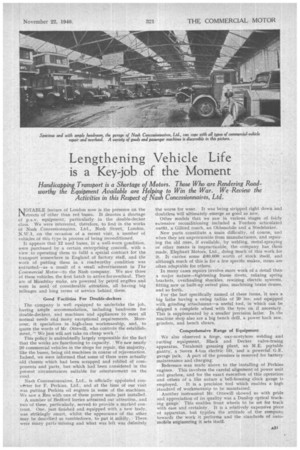Lengthening Vehicle Life is a Key-job of the Moment
Page 33

If you've noticed an error in this article please click here to report it so we can fix it.
Handicapping Transport is a Shortage of Motors. Those Who are Rendering Roadworthy the Equipment Available are Helping to Win the War. We Review the Activities in this Respect of Nash Concessionnaires, Ltd.
'MUTABLE feature of London now is the presence on the 1 streets of other than red buses. It denotes a shortage of p.s.v. equipment, particularly in the double-decker class. We were interested, therefore, to find in the works of Nash Concessionnaires, Ltd., Nash Street, London, N.W.1, on the occasion of a recent visit, a number of vehicles of this type in process of being reconditioned.
It appears that 12 used buses, in a well-worn .ondition, were purchased by a certain enterprising concern, with a view to operating them to fulfil a special contract for the transport somewhere in England of factory staff, and the work of putting them in a roadworthy condition was entrusted—as a result of a small advertisement in The Commercial Motor—to the Nash company. We saw three of these vehicles, the first batch to arrive for overhaul. They are of Maudslay make, are powered by petrol engiftes and were in need of considerable attention, all having big mileages and long terms of service .behind ,them.
Good Facilities For Double-deckers
The company is well equipped to undertake the job, having ample accommodation, including headroom for double-deckers, and machines and appliances to meet all normal needs and many exceptional requirements. Moreover, it specializes in high-class workmanship, and, to quote the words of Mr. Ottewill, who controls the establishment, " We just will not take on cheap work.'' This policy is undoubtedly largely responsible for the fact that the works are functioning to capacity. We saw nearly 20 commercial vehicles in the shops for repair, the majority, like the buses, being old machines in course of rejuvenation. Indeed, we were informed that some of them were actually old chassis which had been scrapped and robbed of components and parts, butwhich had been considered in the present circumstances suitable for reinstatement on the road.
Nash Concessionnaires, Ltd., is officially appointed converter for F. Perkins, Ltd., and at the time of our visit was putting Perkins oil engines in some of the machines. We saw a Reo with one of these power units just installed.
A number of Bedford lorries attracted our attention, and two of these, particularly, served to provide a marked contrast. One, just finished and equipped with a new body, was strikingly smart, whilst the appearance of the other may be described as tumbledown, to put it mildly. There. were many parts missing and what was left was definitely the worse for wear. It was being stripped right down and doubtless will ultimately emerge as good as new.
Other models that we saw in various stages of fairly extensive reconditioning included a Fordson articulated outfit, a Gilford coach, an Oldsmobile and a Studebaker.
New parts constitute a main difficulty, of course, and when they are unprocurable from manufacturers, and repairing the old ones, if available, by welding, metal-spraying or other means is impracticable, the company has theni made, Elephant Motors, Ltd., doing much of this work for it. It carries some £40,000 worth of stock itself, and although much of this is for a few specific makes, items are often adaptable for others.
In many cases repairs involve more work of a detail than a major nature—tightening frame rivets, refixing spring brackets, overhauling shackles, rewiring electric systems, fitting new or built-up swivel pins, machining brake drums, and so forth.
For the last specifically named of these items, it uses a big lathe having aswing radius of 20 ins, and equipped with grinding attachment—a useful tool, in which can be shipped a complete wheel with the tyre on if necessary. This is supplemented by a smaller precision lathe. In the machine shop also are a big bench drill, a power hack saw, grinders, and bench shears.
Comprehensive Range of Equipment
We also observed a forge, oxy-acetylene welding and putting equipment. Black and Decker valve-truing apparatus, Tecalemit greasing plant, an M.E. pgrtable gantry,. a Sovex 4-ton electric lift, and a powerful G.E. garage jack. A part of the premises is reserved for battery maintenance and -charging.
Reference was made above to the installing of Perkins engines. This involves the careful alignment of power unit and gearbox, and for the exact execution of this operation and others of a like nature a bell-housing clock gauge i3
employed. It is a precision tool which enables a high standard of workmansnip to be maintained, Another instrument Mr. Ottewill showed us with pride and appreciation of its quality was a Dunlop optical tracking gauge: This enables front wheels to be set for track with ease and certainty. It is a relatively expensive piece of apparatus, but typifies the attitude of the company, towards the work it performs and the standards of auto' mobile engineering it sets itself.




















































